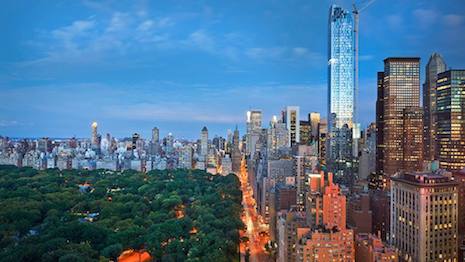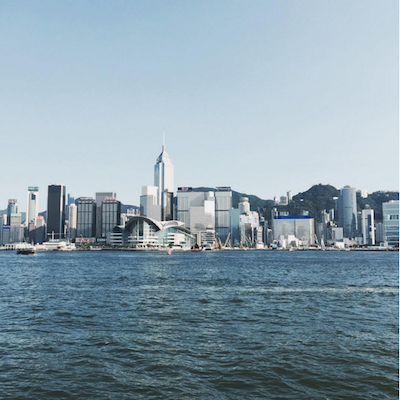London has unseated New York as the global city best able to attract and retain global capital, people and ideas, according to an A.T. Kearney report.
Since 2008 the United Kingdom's capital has played runner-up to New York, but their positions have now switched, the only change from last year’s top 10. As some economists and political scientists point to cities as replacements for nation-states as the world’s primary drivers in light of urbanization, a city-specific and localized approach to business could be a sensible and more precise alternative to current models.
"Luxury retailers are looking for consumers with increasing levels of disposable income, which means they will be most attracted to cities that are growing," said Mike Hales, partner at A.T. Kearney and co-author of the study. "For cities to grow and compete in the future, whether cities that are growing or trying to maintain their status as a leader, they will need to pay attention to their performance in all categories measured by the Index and the Outlook given the substantial interdependency across the metrics."
"Our historical information shows that cities are becoming more global," he said. "This means that cities must not only improve, but must improve faster than others to maintain their competitiveness. Retailers will want to leverage the city level insights from the Index and Outlook to guide their investment plans and build meaningful relationships with select city governments."
“Global Cities 2016” is in two parts: The “Global Cities Index” that examines current performance on 27 metrics across business activity, human capital, information exchange, cultural experience and political engagement categories; and Global Cities Outlook, which looks at 13 indicators in personal well-being, economics, innovation and governance to project a city’s potential.
Changes at the top
London has been steadily gaining on New York, with an increase in information exchange and political engagement eclipsing New York’s ongoing lead in human capital and business activity.
London and New York also flipped spots on the Outlook list, with New York now ranked second to London’s fourth, with Boston, 24th on the Index, nestled between them and San Francisco, 23rd on the index, again in the top spot.

New York; image courtesy Mandarin Oriental
In addition to London, New York, San Francisco and Boston, four more cities constitute the “Global Elite,” featuring on both the Global Cities Index and Global Cities Outlook: Paris, Tokyo, Los Angeles, Chicago, Singapore, Brussels, Sydney, Melbourne, Australia, Berlin, Toronto and Amsterdam.
San Francisco’s lead is largely due to its high innovation scoring, significantly higher than any other city’s. San Francisco’s innovation is a testament to the ongoing work of nearby Silicon Valley, which has already had a noticeable impact on real estate (see story).
However, Boston has also made strides in innovation, and New York’s economic growth and London’s governance have also helped those cities close the gap in the Outlook.
Hong Kong, Beijing and Washington, all in the top 10 of the Index, are notably absent. Conversely, Houston, Atlanta, Stockholm and Munich are not ranked on the Index.

Hong Kong; image courtesy Peninsula
These changes are also due in large part to innovation, as the continued economic growth in Mainland China and Hong Kong has less to do with technological development than in Western cities.
As a testament to the reliability of A.T. Kearney’s projections, the 60 cities that comprised the original study in 2008 have all seen scores increase in every category except political engagement.
In addition to the Index and Outlook, A.T. Kearney also analyzed the emergence of the “smart” city. Although the term is still amorphous, connoting the use of technology in a general sense A.T. Kearney conducted a literature review to find what cities are recognized as smart by global leaders.
All of the 14 agreed-upon cities performed well on both of the study’s lists, and information exchange, human capital and business activity from the Index and governance and personal well-being from the Outlook were particularly predictive.
Get smart
The luxury industry is wrapped into a greater technological revolution and must learn to employ the new tools effectively to survive in an increasingly competitive, globalized world.
Virtual reality, artificial intelligence and other emerging technologies can help brands future proof the luxury industry.
The digital dynamic is not a projection for the future, but right now, and just as the Internet fundamentally changed business practices in the 1990s, all industries, luxury included, are on the cusp of technological transformation. During the “Future Luxury” talk, the eponymous session of Conde Nast International’s second Luxury Conference April 20, Wired Consulting’s Sophie Hackford explained how technology is accelerating at a fast rate to meld the physical with the digital (see story).
Similarly, while there may not a single silver bullet solution to end counterfeiting, technological methods could help to curb the practice.
In a white paper prepared by the Coalition Against Illicit Trade (CAIT) titled “The Role of New Technologies in Combatting Counterfeiting and Illicit Trade,” the business alliance seeks to raise awareness for the technology solutions available to fight the knock-off market. In an environment of rapid digitalization, these solutions will benefit not only brand owners and service providers, but also governments that are plagued by illicit tax-free trade and consumers (see story).
Further, some industries are already seeing how embracing the trend toward smart cities offers possibilities to generate revenue. This is particularly true of the auto sector.
In one recent development, German automaker BMW extended its commitment to on-demand mobility with the new ReachNow brand.
ReachNow, launched in Seattle on April 12, is the American counterpart to the growing European “DriveNow” brand, offering on-demand mobility to metropolitan dwellers. Supplementing its traditional model with a move into the mobility sector will help BMW remain a major player in the automotive industry among a larger group of consumers (see story).
"We would expect the relationship between smart cities and cities with high outlooks to be more apparent over the next decade," Mr. hales said. "We do see strong relationships between smarts cities and cities that rank high on Index and Outlook – the smart cities ranked in the top quartile in both the Index and the Outlook. Smart cities performed well in all metrics in the Index and Outlook, and on average were in the top 3 of any metrics."
{"ct":"yo6+UVvaDI0Ik8PHuwAXbweRKQJElHX6UFrp0XnfDzxR1PiY6EkXqu16zO6fvrHnm0v3lSp\/3KoT\/eGg8dibz1lW4EI5ZK+Eb4hGD7pu45cAJw6vR9JsxVA1G5tq8E6egbtnnUCLRzaNm2gIPQZZ3dT4qn6xCiBRv161JYAPjm6nYEfwAef8BfORdsvVbIA+iDO2voRbGZEpNpuQMuj++vI\/8G43nQ+ZP5jEFIoEmIYnRik\/gEIFES8fI\/hvSEXQhFNGzcCAHlgM2lzzCOTN+e4CpKuqM1qRezn7IVYC6d4vWjMfhNhhfdnsNFz14yatdLKBhyM58t8MGv553y0ddbAli2nnm\/FFZz\/8W9pI2VBFqF4CUN1DudfmPuYEbQFcl+E9rMPQK\/poa5nBQBzgolqmj+FWz22Xfk6mfwFm5gSAjS0YOg7JRB8SGPWADF4C+s4WubkNXcLi22g6nvvGQTr1R23y3OWL7Zg2XIKauhQ4u6ho78jL6B\/axA3vDj\/TXf64JnLNvs1FPZF8KFRQmm9AeYDqEvbGpDaZbLJ5TIx9ipKu6aQgh1FBDYpTpl7Zgnw2kOVsRQuRt8\/F+9Re+xdNqrqmUP2CGFNP6eegHdCOIc6N53rRPEoqGPcrMPwPOlzJcRQajv3F4a8T43l4yKcRyfpUKc+Z95Zox45D56FsfTUQS961pPG5gB1k84W+lIWyeqZJq\/R9LNdtNI9jXSfFkqnPPHb9M3gzML21BHTp6DVFWP9xYS9VY+rs+SVDMoNrchavWZLMxwd7D+KRng2hjLrpMIgkpFLQY3ThDVVkB3ZQEKopS0gZZ6ec1JRcZTke8Iz+CwBk\/9ia4RugZeym73ukZYZCc0Y5Rd5jY0UyW0O0mnkSFYCQyf0a+3ObEmtG9q12k1y+L4gAATN+BhsUJIZUe4TtNEr4rTpNmfH2lzucgtcj2F1uIlCXHW9cwBDcsJugDYLNsjMtueOqsQZFeOQ1rJSW8aQaE7\/G2KlsswYyIWojHYOQmLM7SoJGGyzmn5qTXPV7524MTFLMM3mqq9Jv+McUnsnv\/TyyNbDQ1ICChYHZ+eZwj8dOaxBEs196P3DvuUbNenJ\/ELrJjqqaQ91GKONNEE0Bowqlac9f02FwLwOmCJqTQmUd+k\/vEvWRRZFSqCi9tsauHMMQ5HBfSNdAVH16n5AffVQHh18gtyesf0fuFl6azJ\/LcGQRm4\/kInqByV66FRNbGt03SdyRsibJJuZ6iZS1BZrPdPOi3ca3w5+tgK6M6rvmKm32FIjTiOGYwMbAwKr+KBoIjVxDf5RIYgekck0KIO1wXXaYKoyHx6zHTDm0DoPXjZQCDsCPJMONuiu5BV+34mPs6flKs5oOXWoshY2OKudNdbT1f9QXOhrKYQLqSlqmEzEyDbjGNtlNt4QfOkcpTH\/BanHitvxKSnAjwhRzX58ex8Okz05hxJzoPC1EB45T7uKgtY5nCWqchnqGe5eYQTjmjNBtBmz7ieNJtJYMPEn6WocPoChf3+xKTS1viW+TiOnztvSTdPVdGsXYUqhz5zz\/Ia9QCtyT1oHaX7WZw9eOgvGUV5XzUyIN5EDwo9pDIm9csTFKbXPRs2Vpma4Z1rk9nYDQaToCZDcZRmGqAQwuIVGfPiEN2B1NjOXvppX\/pZaOaN5lil2KzyXVUjRVfLxpkiHdBddqHmC0obDLmA3W69ZewfbUpQYmLjEKNS118Y4WOsXD3+rqORu62ypnL5MKRZNqN9NNzonX4veZJ1sySRVfmTD7Am9urE5xQ8Lh9Z5N1JMR+DHbid7ujSBaX2DdOtOqaQGavBGuv0++Oqidx1sxQR4pP7eBsMe0fBmGqwpQUQW3BvWQy7TKPQczq7rTVyQ+itBsdobQD9y3kOh0W8Io8O4Kef3H+0LzumRwrevtMH+6u90ZgpbAMFHugUUw8wO03\/F3haeo3PC2O5GyGrrgReg1\/1RIDLeUtdT62RTYtIEcFZxvDYP0MVoyVdvc0Sx8u9bPBua44ika7voriRKWp1SxOktBKYK6IzsEVFzGHxzdZhf+NqF3hHlmW8fW5NtF8b5TUNlDJm9F2KqQbLXgd18DQRZ1FiH9gN9yJ9TRDCKYjgvh5PogShpqW0+AvAXkpwe8TlR\/vUwAdmNNl8jKZ+wffDTh2l8j2xfTTUWiPoJUgtCUdSon5nBqrWNecEENQUBMkqZl4wjE7Oo3at1LgBaZRK9kLW4hM1kgn2zPJh4tOLKHbvc4g3ompDOluA7nP8havm931dNxQebiQBBaE9UryhOjmOe+RFsUcCrrq3MFKXLcG5RdkPVrBJI1WqdechCSqIka2M6HUFhynPqwaiJL83sppMn5ZkX4Mq\/ZQB8H1Q16TKPTkA+rHPfTGgdYACp3gTn0A4JOEeAvHfKi9ExMO7utlXj4iDquSudkhCSW4PXhQR\/3P4RNwgekHmjrTGaGxWSS8fQ28DxLAp6VYfrpfTmdx42332zYSkdtye017cH7hOf9OMD2fe1msH1WuJ0QppRN+y8V5ObUrbhp53jkdRjJe8XzLO5Ww10jrPRhnnFZj3TCLV+EjsS2IyqoHC4aDIZ8+fNFDEYNfa1p51afoRyzBc7XIDic80rw\/Oif2AinaZkGrC+nug+b4f2tZgDpsSevWvb+R+cPJGbBbN3Ab4X65TeJ4PgMU5nX0hUpWVN0fKwlatAhoIBTO+ZvprqQucwQkavVEZBesY78UZNzUPwjL0XdXMcV6rBZ7j\/wzDVUg+SBSs06LTAGT7wcvI0DZ0vMy\/7veUDi+m7rfGNatBCgs6YW3loV\/EWeZkRDdZzfl3K2pJMa5kb96ftT3Ga2fC\/w2MeaxC2oKTfk\/JOPODyYCfik90QNs3\/4jeB1XE5BJbupGTaUSTNeFhyON1j2A0v7p5hVIGMhN5qxctLuF6LFmdPJVnCsD+83zmXuqHiAOmUOuADPh9qFeqdP8M6p0INqQXy2q+fTPAg5kVPu4Q+ttI+qE4C7iQPq0GdFJkrfTusfbvb3h\/HiAYuf0nv2HaKQ1a\/KkF\/u7q6TcOti6B+7F4k6mQUHpOQjqdwG2kjsZCZgQwDVzPr+2+n3+uB1ZYxVaDY2i50EmwXaPXmFP6lcxhdyZH+pOeys9IVZEqUNuXDx7vjXydFOZfmUQbRL6VhrEkPUo3kOq3ttCliCTKF9fgeoDJ64JCCMrzESbcw+uq2H0vV8jmq0Yrr2oTh1fDP+lq0m8mpDrHndRogr6xWBY9Pn+B3SRBcIrKGXWdZXucYJCrOkIFXI9tUUgd666U40m5MXUsYYyxI+EIsf1ylXNN3K+LuheIsGrenW85LaDc5KhIzcERG308ZthWjeIW+XIBbBMQAOV8A+hcvs\/oUddxW2Q1\/sDJrJs3MC\/zUe1ZRMOIyWwi6LUdrRMFFwgbnAGt5FZ0nDqmC\/hkut6E5SOlLmgb7crJd14G+oErfDdKWg59q3ZiHIqSULJNxYT45gpShlfHvUZOx23Q1480pW04EHFz\/QgBqsKxv4t9GLW9Mx9UAi8gOw1RV4o\/WkJ\/WIFiQ\/wqomzxwg7V0WEB0qjhsQqIXldfPVrPCtrCnBF+HOQmdeQbSAt8P0UANdqYMENwc28zwotno+Rnm\/T3FZ9qapavsBUiSd0i1fW3OZZypVOhcWyZIWkwnuZyhqBRaEepWBxZ8J642xAwQqOWKmiOnjc0D1ZLODBk4Ys2k2Ls545EQlxrDjpFpILpw4cYzSyViO90dIoR6o\/bA2\/McFjUw8lRcFz6dx44cnca1g3LFreKV68PLzSkAnF1absnfqRzP6WWoRIOb79ilHlDrr2RHeqh+Wuy5Tbq6QsQMIAwZK3Aiov4MQv9xCj94ZRXZ2Gz3vxnkfMkc3+fC1zWtDIAn8zhEEOfFE0ldCtTejpN3sQGYw46drykasg2\/X8VTHoSV6NT5ZyTCOWtqCFS4raHwsN1xNaD6Yg+s697AMQFD+9M6PU8peEjkZA72JCHdbFnJo4EDw0TMZDdL2Y3\/\/8Zp3qR4vASA6tIf+EIaSjkcLPtYcj59eNH4TjN0lQPOtUV9ZG7DEvwXQg4xZNduARtbbIQ5VDkFWm0aQQAjZfO+cl34swH0RzhNGVK3AEcIAaaXZH\/5wFHtvkas6VO65kymN3R14ryERBxj3uKX4IvekLoAY4geBuymhaTo8xDNoDmnn+iBoJNmrupn2W7m7oaSeMx6HO8oXYyKx07pYMbVL1DkV+DbAw77Ps0YoM2G+dP8YtZk06Cge2gRM0219OK+7cinoRlxecI1eoG\/e8W9VnMHzZaYxbdb1fPoUB2pyEnutoROpZVF1sFzXn8zKs7lCk2vGNllOw+NkU\/YOzBLW2lrPHjLW\/hhzXtrqk2Q\/ZmQohxmMYS8vYQGnlBCcBRvfT21JB5ngdcX62yum1buL38bDnFrr5KK+5KmAMQ6se73tFdhSyaQBheZxBGkXPOsEeqgdfvJPvV1lexJf2k7Bso8CTstFvCcupLl7N8NT4Gu86FbAGyAIIRuPUtHVZodfG8RCAO4JLSxZpyBEM5aiuugc4Yna2O70NTbU7NSEzoTYidaHo0c\/kIeHU5YXseyZ9\/iDO7C6+e5YbNCL4akwosCm59giMXAE9lkJ74dHaumTza0Ioe8wqSoiHHo+BeWkSlH94VPHnM02szrC8RYdJXpHBNNOUawp9Y7PN+w8AC+bonatWqg3v3jGSi5QdbAAg3cny25REALDw\/y6obf+tPxeRndzGRBfadutiDkU2znzV+i+3YeZRBC5v6PqZENj68Zm6AZy7y+tK4rFvKPG6QJxlzFT2n82lQ5NrEeEhbjNedaMJr3E84IrenJQMmTlCxwm5qkf0oB+zzHdH3i9WBqAo1tMPmnoCKgD2NYMIGuwKuVCwnpgTOpqxteTo+w+K0k3qAP3oWdsqIC\/S2AprtTUt223nFjxCV3fuCIVS3v6NdHp\/85RpXZ69oSvvO76C2NXqZSvB\/\/PolXDH99HhwLW2cKSeTt0xrcUhcwKW1uawQvigaAtf\/r5sB29ydD+eIyHoqTE3qytf2UzzlShB+A\/+6wOli8GILGEJz6Ltk575zBGN4oeJ49d5WBIcDMfY\/HUuzEHz+gjKWGkpqQFCGZHntp1ipa4B00qqqkrlfhJr97UdmZ3iDuiGddiD1lRAOC4C979JWcuqffHeCcZjvejDhSICT2Zv0d1KVcMUQ86RtLRInXjpc1DW3i93SBXiN89fvG6NTbIayudDnH+cyGF1ZMDuoSwSoq4lb34hMp4bG2eNOld1vaOVn1QXRiJCjR+rYfLY4DKY+y0fNoSEVw+BT5QSmIBHleAD8YmhvnLwMBK7d3eqGLa+JE8jwZdyacGk1AUMZ9GfP6PwrCtUw1G7S0emKqbSLKp54gPUHw1+UQZmxzGMWAGQaN7hM1zSDeRnHwNtzOjbL\/5Qdoab+HJpr7mPADSbikt2RJamh4evbIwaDRN0XdLs737fFYQVGHsiL5hQe2EpEen1+lgZL9AqzU0oNGHagxU6p9wBczW\/DGSAQL6fTsUY5eT1ALNiULh\/lDdb26HIZ5k\/0EypKmmmSQRkMLTWFOQHhdPqI1kJavLFaEdVJw6ojszL0f4dKF+CNJH8g+xLUf78C2FSR3EYQC2R4jmJv1ZQIGLfGWmU9f+8dF3zu+7pS6s5\/AsbhvvwLhYdMONAeauQeWP\/tasVxx7TEf46X8fQhgZyjUoWwn7R5V\/QSR43gSsvjXTsMslHEXhz4Zjqi9PByQd71VAOvdq0SwZOrVjx2uw3n227n4ezThxtKMy9Pw0iSzZwHJILJwJl94vFv9\/SO\/pw\/G1uiZ60vH7UpDcPZ7dLkljGzVV3L7raeBJP7gxDmbev6cROAlSSqHWOOy5Gsd3VpdWqkFIL6tvWeJgEBi4qwERNgz8Y1VkpxWSHct2fntEJWk4k\/xkHXE47lXzrU8sbRh3Z9T4JrmdCmqULUUkwqGen31mLUyA76zf1cl9rzF41+1Tj1zgV6wgSkHccUQvn7E1CcLebyMj69O0itq8W8fbTwp620891R7neynff4YLs2KQnGSpkruNERWXAPiPJkQPcRHK0FBVfpNhhMerOGgB2or4mFe6by2S17cW8fv+h1x0FCe5ZVXKuDwwP\/\/MwKrkFOjKmGVP1eiCRy3DpFClD3A4vz5q91MYoftRHq4Tf6wgLcBTsYx4F1Vna7HkL+prn5pcrWd4Ir4STqL47C83j2LCLiJByfHkKNaMWaEq9QMq6cqdc2uETgvAXfy7fr9CoFvYeFmExPgUt+YGs5wg+Y1RIgcl4FDpYrlRrftB+TIX7msGaTSV8eHT6XU2iGTITvkZHWMrGRipRZSu51c1r9czws\/xtA5hh+vjerzH2Ae2+rDn38kadBDhTDgm0ZCmyEXxGCi8aIjgazP+uV6E\/liNYfVGrrlusWFQQ8DNqDbU2sT+KWPq7c+U4yVv3WSF61\/6mu9THX4NgKyCbs4c2moa5dAhNHxushH3gDYHXPQSIkRB4\/6WuXnG8EF3KrGBGiHQ4K1xUytLBqDKMlC4Iv+9ymwsYpznU4u4eA4EsIkg0hT24A8w6AB+p\/mJQtmaXz17uXzMgG81Wcd+RjZWiN2fZvr\/w8syL2YanV3i81+o9984I5geWInUlP1QQljx6iWSKB0W2a39F2RPbRp5T45YJt4kXQXiUsorPxn50sGddAeYhLeLlFTzNBus3Fq7gO2Ko1qIIMJYTodlwEJnuZG677MuD3jiD1+B+ZDIAxzfv2d0LSQFC2KYll+o4ZT5v5Utr5tx2JZhVUDujr8rngaGgp9hLk4twdZqet1tly2thSJRpUKIvZG9WXIMGPew+y4Qi8ifCFywSdkNJHHkIAgBIdC8KeOXLaqT7M3iZDy0vb6He8MRznn4Dva0HQ9rUX3bjPfYQGKnwX4BndxkRktMlKkG4IAevqcN+Sf7g4SRY+rG9XpHd0Cap4\/tLVTE1PR\/H2SvE0\/lXFtqxHQ9yZOP1WZfmK9J8A\/Nz3us+uIG8C7ZYjYC+C\/BghoIxrS5MOZFvXSnMJhcqHftx0Dz3Ay0lH4ZUba39+NW\/uOxg2e+v1Lp58W6Ko\/dUJHan+bngK2yNhPhD7bIoPeEtUUJOergAo7NI4ph6WOFzq+bet5LibjexgwUKeMg0RalyI3K12SJrAzTJLbM7gd0yvYuw\/cvFGoeAwBxNctgSxSiyRvkjA6Xqx0sB+jRpCdKHHeVx4mXgXOmQHVEwRyKzIw8G67MvRCsNwqDjz0iWF6Q4TnCf0XiWNV9zUBzE4Z87V+29RtmgNIxaj2FA86iMATIkwU5Lev3U4kSVDNa6HeroQJCJpMrUa6kqGh2Dgp\/Qg1cxL0MEINsMRW3L0g9KFEje7NYTe1UitBmFMh2w0Y067BsFm\/2sx1k6Rw5+2CHeFBE1TGo35aA2fcUg48oJ4mDeVIZUnA\/HCsrw8fB20FdKAya0lQU5nM\/YxnhgnATM8VxiC66p7yx1wxc+8hpP\/G8LuudV0AHWVunHVETzN4KSp9ySIngGVCqZDu9mKWsrG+gA7zQDfiUw0+ldxeqcOuRCUKSSy59Ng8KTlrsY2cWd2Ufb3ac+FsneepGpK76+PFOeWy9pLOYxLfnYO2+i\/+6ScylOimoKikl62xfIAbYynNs9KAKEPqtSmXY4Ot7xD0TgPDBM9i1qxDwIR\/NUWF+LEUZJMlbrNcoa0TskQwfumurTLKGK\/wPjFXjsSQNXYipcmzlcCi91KnjvaZFaxKWFEt3T5MXBy8bogfvxHDcq0d+lPzllAzxfHtqXdd9YX6\/lXjoN06aV5ZD80pYtWPKl2aLURDZlQefR4CT9Epjjzks+OilhrTNh1NShy0HOsRvVbU8XWjQd\/G4iXFb6GM\/1Kl3rsBUmI0z\/7bMgNbfsWc3w1DkndgQ5OMBvXffXnncoeNRxNybbtRYLZ6CvBgGTauicGZ67aO7X4aLtMfQsPeLOLRcGBdOuSUUFu0\/pQMkO3OLt2qk2N3bk6cbrVM6Ow\/Ynr0JdKtVKHemFJDG8oVFXwhYnLKI03SZ9WipvNXyqduXnJypjL3hrT\/fYdAdUK7\/0rzIH0sehJCTB07HvCRhltWksI\/k+3Ks4tVrg\/xDb7Y4SfPEZ5Kdoi6Db\/XFY2ddGBlO1Ibh1TQxP7r+Sioju28ZzylTO+mo5eaWz955qaXMASMQp7Uiugbxu0QTcRKyPi1D0xs1e\/nVCNn3fgxnjMU+xHTpPvgAmQAOMlHzpjkuyQ0Zeo1B9oho24RYXz+nUlhjAiRjEwjZjbB03tO5wLYukXOwPCO7zqIuOa1aGsBpXDzY\/Crwvzxik9wcvWjNGMs\/I83j1wckYIxAOzqOTWYB\/eEYi8gbfYjqL30OBTxx7wi3mYkvW9MlyB7bxIvJ93AQWW2n+7KYA7jAmfF7Iy3u05CfFMoYYboU2S5Mh16qSgiDUCNaPY542OgOLDxNwgQf1AGmfI5z7MKI9GmQV57MBcosar2w2h4lmffmhc8ioPiBa0pHC4N2L6hV5Uvfib37dz3DSv2+KMpP9BPSR7JUFxEclLDzYXxXEDdP9YVeAXss0xVTxarngsysq2KDobPcOVnkjnSsrvr7UVO+lSUwEOcmrD7QKNDinmmAZ+uRRgocrWJaKA\/8c9qNaO8f2WJw4yNkmNDsBEvij75wMKP6Y7amj7Dqk7TsEOF2tfvy\/Mg7rqPK\/62R9VeksPoSA9CQRs2w751ZpLwTbKzVH0xWBsP+A5lHPMv3J0+gRzm53uXXDLkTqO55dExMssAZiq\/d\/Vvlg5i+8doP2wB\/diwhEYmqMrewhr3lZKciAuOJCmDnGfIOMSCLUt5tRFLd8QQlA73Dm3Ih1EQnJu5gXSJSKJ1e6Hc4i9zb6oMrMJdjqn3XHdDMdrd9VcVKG4\/aJkwFzQSqneTOHKVtjjHShjEPQWOvohYcoJnFIhwX5itgvdsHPXmy2JPKYbnxWCudkRhDzCwU0wSQDSIscbMtuO0J1iAsYNMgG1u4CvZ\/PstbbDizWJb8WjozSjALHpW6Mt8ROJGSjbc\/HHRMj6SVsHhWT9dbz2+7FRXr6AaN9aVUcKKuwVTNXggW8dahici6zunysdxJBBtl\/7Tr31MvIWMnomWsEgDxHgRhnYV+wVyU6Bfo3vO04iW5u0Yl4ToEuGFznv0sZ6QaiGqQqxLK8TWjYwzBk+niohShjZEGdT\/ygZ2Hi7wA8BtJ95k5M0vRowu7pmjskBOLYbb9sJsJo5CdlxsIBs8ZHIjGj8QTQpGvHbp7xIv3wrGrILyeihZEkelP02uu4zrX1JnL4WFBJTgDu8wAwSlBOkVAM\/YwZEzER7hSIzngwH3e5oV6YwD6XWd1f6MqIqkBktwApne+RM0nf4UCtPxPP\/LYY1t6n2PEP\/C4JGnYsrNSegTrzfIRjdx6ddYbSbV3Dhzg6BMx5UZFq56fjtdgydKv3WaF2pa\/O7VjO2Jr40Tm7Ymn2BEyMAyaoEFwTbfhoos7ujMjwLmilAkPWYzGtNEfC4ZgIoojGhaEdtRBCwPEA22D9Zg14zWO+e\/aI9o0CHVdsSam03K52VG+x55XMNB7wVrWyg5Q4Rq56lTszjJLcKHvIinNrKyot44y3sSp+wGqpki3eLKjAMGJVXC8EbwTmJGGekX8dp7KWVLQP97MO2Yw3W9szROREmzD+7eVHOsaXUSgaM5WSQZnGkN8Lx02Lr5unHcmP9No1lZ2bbzQqE0FSdC\/+pVI+S2tCcVEz02Nw2g2r77udil8by3SqY1FaDfMnH89GndXDK0ea2NAuPwgs2bsQ7BSj5Ab+49cZwV7Z73MPBFqB2dfrFQxkm1iJNFBY4Y43CXOKuse7ya+THjiInANfVUoE+Y9bG6kMUd2\/JeidjOogRXxAfqIVnsbDF9+JPyN+hIE5vjhKQ+awdP7woP1PmPidTZbCpk95E3gKNA57AjkBB5K11alSrvIAmZ55hiIr16fU2pG9+fLPzloxR+MCJ02INxZWxoHxJFQHtOL0X1tTbKrIpvcgXM9rcNan18waeJK\/jjt00cfis2y+7rYUi79GvPjiCPgOYhVAl\/sG7Zo+KZtUaNaPbzaRf3QJHySVQvFkYrEcACH5A\/O6i73J2iSz7FRZAGpnAIZ0ag6IjMxvhlEcyeZ1QqZ\/Ho2vT0HzvEEElLKQbjLxstf4WPCTTGfX664Hsjr+AtN9JnSIV5Dgb\/l25jbkGuE4laxspj4OcJigzRWG+E+MtEzr5WNCeLz3Zjza0BLmr2Uc2m926hpMVXUZ7mOmqLfGnXPAA46YdnVOu\/WKyFJByoeLjrbVktXpEPh3QLsC6DWq45hIk\/uEIK1eOXIag+RzNuC3DvDeX8vmUm7hlIBqfPMPz4\/aaQrGysGH\/t\/umemguDLloaMUiZ2sYTtoRDBOgiGe8+TjMcF10PeUr4VZQE34xicmuSyz1F87VyKDOR8yV4nDhTquitFw7H4iUH8gBzOhqOZoPHgPsU9jK9d3faUwH1falLonQfNuAUdl6gRjxZcevvdkFzpJB68E3qI4VXyWj\/fXVQ0LJvHc1NMV\/S+FNpug3wA1v+\/OdqxgrZP1qs954Gcw1YOYH3GpGttVnS\/1tz+HfwEziyqHJkjazVkkHdyIi89ywcrc3TmzB219oTQPM90YSDiawx4hTk\/LqWezttf+Pj2RQdryYRX0ciuh1\/0MNXyWrwrfP3Ub8Na6hVtAD12o30+0gw+Cw\/Cz0KklBJodkZBkf1NgazRyFWA7vkPzd1sCLz7Mk0QS\/1RPgxRcrJovihuF78O+WurJADJuESlP0UG3q3u1bXRzDZmVkwtSEzhl1U4uR\/iLDW+wz1M9mVqaqPJDJfbG3fCrU1ZT9CzvdBzs7gxlN+\/fu1nlN4u4sFT+9oGHyDrUwB2PCDqoHQTcWfjoqs0iD1f8ghZgMOclm\/H3g41cGzgpWIQGMsE7Pb\/twiWqaIDPGO+nMlPZOeqZlE8ru3fDjYCRA\/Oft9vFUNcjbrXfHuJxUNvjUEJfnM31NJSxKyDsWm786HkhyBOzgRT6LLJWv4OSmH1lMurksiG7YInmyNJXmYaXFcQFxys1BLWO7rpTWgpvBYEqgUszpFIjweikoTRfWZ8LqlT7js8xdKsrhLqMGQDhrsJuVnn5GZmzzIcW4p7nqsc6Rfr0+F37X4psKlF\/dbA1eo\/Q6dt0yGb1dW7bJ4SBu3rS\/XCmKpkLeX8hrPVLzcF24CdpAMLzgBMZOUkRrc7L6CXhCwO\/09RQUTD4BsOzW5BUXEsQ9zdGhMXv1196N4LFdd34QjJHld+Z1oa8CpDY6BoxIhb0y1hXFuGSanWr5OumK2tYSOd8tUFNJcrpzPgOBGyVjpAUQOn9KA1ViXd2IwmqEQ2Ro3vrMttniWFPzsXddFrMur09IRrJWM2qvzLXXLJbhitLN\/z\/PE97Tw9Zr2OhTd7riZGAoDUXX5IXM1HpWgdCMvkH63Iq5JFckWgS8s6wS32wYAyNdvlyCNf+XBaWZMUDq2DcM5iXdVR1nOYDkS4AB0djfjsMgqI\/G6wjyzyRoz3A4GAAod7jwnGE7WmA1qsqPTU9R9vYyuU1SIKrh39my8+hkq4Nd9es5K7OYsSaEezmmzwpufZP3Bg28Qy1O6dVJHX53O21y7oW3fABehy38FZljiLpzsP0rRvTwwBAQfWhtMHKb+1I\/0CxSbPIS1zdQE1UTRl6lPr+mWFmoHQN1Bg\/bStqqqWDPph1xooL+GVS7+qIytl+0jB+1PkH\/kMLRWe3ih+CDBk2YAnVKAXGgNzVi2VLu6ElEMYJbSE32N2Af7Ksv3bKuas7tCF1MtFO0y9xSrVuczYsfjx0Cc\/3hVmxO8X4u6WA2dv6k+b","iv":"efcb3bd041cf387453eb8461c7feaafc","s":"dfa77350e64c2072"}

 Image from Harrods' The London Edit campaign
Image from Harrods' The London Edit campaign